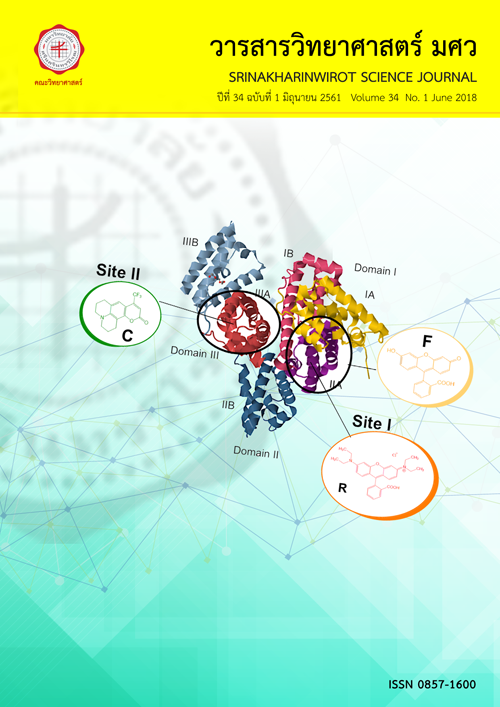เส้นใยนาโนเซลลูโลสจากขี้เลื่อยไม้ยางพาราเป็นสารเสริมแรงในวัสดุเชิงประกอบพอลิแลกติกแอซิด
Keywords:
nanocellulose, Para rubber wood sawdust, polylactic acid, surface modificationAbstract
บทคัดย่อ งานวิจัยนี้เป็นการเตรียมเส้นใยนาโนเซลลูโลสดัดแปร (modified NFC) จากขี้เลื่อยไม้ยางพาราซึ่งเป็นเศษไม้จากอุตสาหกรรมเฟอร์นิเจอร์ และถูกใช้เป็นสารตัวเติมเสริมแรงในวัสดุเชิงประกอบพอลิแลกติกแอซิด (PLA) ในการเตรียมเส้นใยนาโนเซลลูโลสดัดแปร ขี้เลื่อยไม้ยางพาราถูกปรับสภาพด้วยสารละลายโซเดียมไฮดรอกไซด์และ โซเดียมซัลไฟด์ ฟอกสีด้วยสารละลายโซเดียมคลอไรท์ เซลลูโลสที่ถูกฟอกสีถูกไฮโดรไลซ์ด้วยกรดซัลฟิวริก ความเข้มข้น 64 % โดยน้ำหนัก ที่อุณหภูมิ 45 องศาเซลเซียส เป็นเวลา 3 ชั่วโมง จากนั้นดัดแปรเส้นใยนาโนเซลลูโลส ดัดแปรด้วยเมทิลอะคริเลตเพื่อปรับปรุงอันตรกิริยาระหว่างผิวหน้าของเส้นใยนาโนเซลลูโลสที่มีขั้วกับพอลิแลกติกแอซิดที่ไม่มีขั้วด้วยวิธีกราฟท์โคพอลิเมอไรเซชัน เทคนิค Fourier-transform infrared spectroscopy (FT-IR) ถูกใช้เพื่อพิสูจน์ การเปลี่ยนแปลงของหมู่ฟังก์ชันบนเส้นใยนาโนเซลลูโลสหลังการดัดแปรผิวหน้า วัสดุเชิงประกอบถูกเตรียมด้วยการหลอมผสมที่อุณหภูมิ 180 องศาเซลเซียส ผลของเส้นใยนาโนเซลลูโลสหลังการดัดแปรต่อสมบัติของพอลิแลกติกแอซิดถูกวิเคราะห์เปรียบเทียบกับเส้นใยนาโนเซลลูโลสที่ไม่ถูกดัดแปร (unmodified NFC) โดยวิเคราะห์สมบัติการขวางกั้น สมบัติทางความร้อน และสมบัติเชิงกลของวัสดุเชิงประกอบเทียบกับพอลิแลกติกแอซิด ผลการทดลองแสดงให้เห็นว่าค่าอัตราการซึมผ่านไอน้ำ (WVTR) ของฟิล์มพอลิแลกติกแอซิดที่เติมเส้นใยนาโนเซลลูโลสที่ถูกดัดแปรมีค่าต่ำที่สุด สำหรับอุณหภูมิเปลี่ยนสถานะคล้ายแก้ว (Tg) ของพอลิแลกติกแอซิดที่เติมเส้นใยนาโนเซลลูโลสที่ถูกดัดแปรมีค่าสูงกว่าพอลิแลกติกแอซิดที่เติมเส้นใยนาโนเซลลูโลสที่ไม่ถูกดัดแปร นอกจากนี้ผลการวิเคราะห์สมบัติเชิงกลพลวัติ (DMA) แสดงว่าเส้นใยนาโนเซลลูโลสที่ถูกดัดแปรเพิ่มมอดูลัสสะสมให้แก่พอลิแลกติกแอซิด แต่เพิ่มอัตราการคืบของพอลิแลกติกแอซิดเมื่อเทียบกับเส้นใยนาโนเซลลูโลสที่ไม่ถูกดัดแปร - - - Nanofibrillar cellulose from Para Rubber Wood Sawdust as reinforcement in Polylactic Acid Composites ABSTRACT This work prepared the modified nanofibrillar cellulose (modified NFC) from Para rubber wood sawdust, namely the wood residues from furniture industries and used it as a reinforcing filler in polylactic acid (PLA) composite. To prepare the modified NFC, Para rubber wood sawdust was pretreated with NaOH and Na2S and bleached with NaClO2. The bleached cellulose was then hydrolyzed with 64%wt of H2SO4 at 45 oC for 3 hours. The obtained NFC was modified with methyl acrylate (MA) to improve interfacial interaction between NFC and hydrophobic PLA by grafting method. Fourier-transform infrared spectroscopy (FT-IR) was employed to investigate the changes of the functional groups on NFC after modification. The composites were prepared by melt blending at 180 oC. The effects of the modified NFC on the properties of PLA composites were investigated compared to the unmodified NFC. Barrier, thermal and mechanical properties of the composites and neat PLA were measured. The results showed that the water vapor transmission rate (WVTR) value of the PLA/modified NFC composite film was lowest. The glass transition temperature (Tg) of the PLA/modified NFC composite was higher than that of the PLA/unmodified NFC composite. Moreover, the dynamic mechanical analysis (DMA) showed that the modified NFC improved the storage modulus, but increased creep rate of PLA matrix as compared to the unmodified NFC.Downloads
Download data is not yet available.
Downloads
Published
2018-06-29
How to Cite
ช้อนแก้ว ว., & อ่องทิพย์ ล. (2018). เส้นใยนาโนเซลลูโลสจากขี้เลื่อยไม้ยางพาราเป็นสารเสริมแรงในวัสดุเชิงประกอบพอลิแลกติกแอซิด. Science Essence Journal, 34(1), 263–276. Retrieved from https://ejournals.swu.ac.th/index.php/sej/article/view/9445
Issue
Section
Research Article








